

Hacking the Classroom: Beyond Design Thinking. Design Thinking is trending is some educational circles.
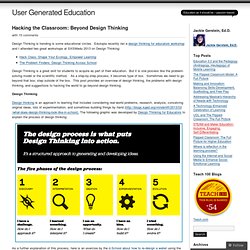
Edutopia recently ran a design thinking for educators workshop and I attended two great workshops at SXSWedu 2013 on Design Thinking: Design Thinking is a great skill for students to acquire as part of their education. But it is one process like the problem-solving model or the scientific method. As a step-by-step process, it becomes type of box. Sometimes we need to go beyond that box; step outside of the box. Design Thinking Design thinking is an approach to learning that includes considering real-world problems, research, analysis, conceiving original ideas, lots of experimentation, and sometimes building things by hand ( The following graphic was developed by Design Thinking for Educators to explain the process of design thinking: The 5Ws and H – Structure for Uncovering Truths. The infamous 5Ws and H have been an integral part of journalism, storytelling and an uncountable number of TV police dramas, (Law and Order being the best, of course).
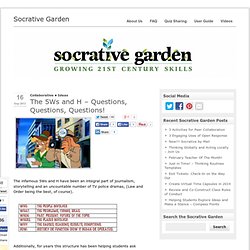
Additionally, for years this structure has been helping students ask targeted questions as they dig deeper into factual information and uncover truths. In the 21st century, this routine is more versatile and as important as ever. It’s at the core of problem solving in the office place, evaluating what’s what in cyberspace, and identifying causal relationships. Whether an ELL teacher or a physics teacher, you’ll encounter numerous opportunities to cultivate your students’ abilities to mine for information, make sense of it, and then arrive at conclusions. So let’s support the development and acquisition of these cross-disciplinary skills through whole class discussion, practice and guided examples. Use the Short Response and Multiple Choice features to ask questions of the whole class and deconstruct each W and H together. Once upon a Time in Marketing Land… Why Narrative is Key to Customer Engagement. In a saturated marketplace how do you make your content stand out, make people take notice, and get involved?
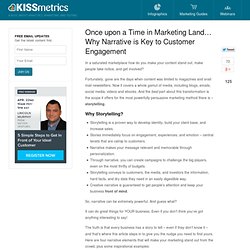
Fortunately, gone are the days when content was limited to magazines and snail mail newsletters. Now it covers a whole gamut of media, including blogs, emails, social media, videos and ebooks. Great Twittorials for Teachers. 11inShare Following the post I published a couple of days ago entitled 10 Video Tutorials on The Use of Twitter in Education, Lieberman contacted me and suggested more resources on Twitter to share with you.

I checked the Twitter Learning centre from Cyberwise as she recommended and I found out some really great resources on the use of Twitter in education. I cant believe I missed out on them , they are just amazing. I particularly liked the 5 minutes long video and the accompanying guide. I am definitely adding these resources to the Twitter for Teachers section I have here in Educational Technology and Mobile Learning. Check out this list for more articles on the use Twitter in Education You might also like: A Great New Twitter Guide for Teachers A Must Have Guide on Using Twitter in your Classroom 10 Powerful Twitter Tools for Teachers Professional ... 134 Awesome Twitter Accounts for Educators. If you are a teacher who tutors, for a limited time, you can register for FREE using promo code: usteachers.

“Teachers are great tutors!” Teachers keep 100% of the profits! If you are a teacher PLEASE join! We need great teachers who tutor to be the #1 resource in America for parents looking for tutors! Students Share Characteristics Of Their Favorite Teachers. A few weeks ago I had a Twitter dialogue with Reed Gillespie ( @rggillespie ) an AP at Kettle Run High School in Nokesville, VA. and Angela Maiers ( @AngelaMaiers ) who coined the phrase #YouMatter and is an author, educator, and national speaker.
Our conversation revolved around a post from Angela titled 12 Things Kids Want from Their Teachers . Twelve simple and free “things” students want and deserve . Don’t we all deserve these? Reed shared his post What Students Want From Their Teachers he wrote after visiting with students at his high school during lunch. Very similar list. 12 Things Teachers Must Know About Learning. 12 Things Teachers Must Know About Learning By Bill Page closeAuthor: Bill Page Name: Bill PageSite: About Bill Page ...
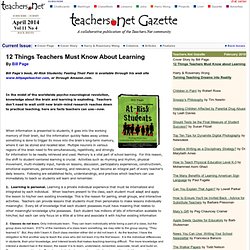
Bill Page, a farm boy, graduated from a one-room school. Introduction. By Howard Pitler, Elizabeth R.
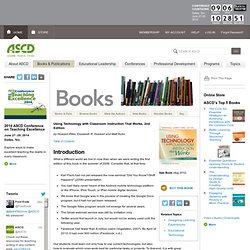
Hubbell and Matt Kuhn Our students must learn not only how to use current technologies, but also how to evaluate which ones work best for particular tasks or projects. To that end, it is with great enthusiasm that we bring you the second edition of Using Technology with Classroom Instruction That Works. Technology books have a notoriously short shelf life due to the constant evolution of hardware, software, concepts, and ideas. Even when we were writing the first edition of this book, we knew that the book's content was likely to be short-lived—and yet, that first edition is still in the top-40 rankings on Amazon.com in the category of Education & Reference > Schools & Teaching > Computers & Technology. We think we know the reason for this staying power: Although the technologies we discussed in the first edition may have evolved or even been replaced, the purpose driving their use has remained the same.
Confusion Is Actually A Good Thing. Friday, February 15, 2013 We all know that confusion doesn’t feel good.
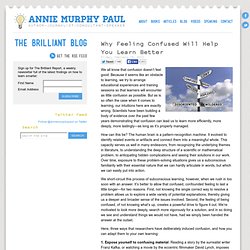
Because it seems like an obstacle to learning, we try to arrange educational experiences and training sessions so that learners will encounter as little confusion as possible. But as is so often the case when it comes to learning, our intuitions here are exactly wrong. Scientists have been building a body of evidence over the past few years demonstrating that confusion can lead us to learn more efficiently, more deeply, more lastingly—as long as it’s properly managed. How can this be? Teaching Without Technology? Lenny Gonzales By Aran Levasseur New technology is a lightning rod and polarizing force because it not only begins to influence what we see and how we see it, but, over time, who we are, writes Nicholas Carr in his book, “The Shallows: What the Internet is Doing to Our Brains.”
It makes sense then, that debate of digital technology’s role in society is naturally being played out in microcosmic form within schools. Education is designed to transmit a culture’s history, values and theories of knowledge while also preparing students for the world of tomorrow. 10 Tools for Creating Infographics and Visualizations. The author's posts are entirely his or her own (excluding the unlikely event of hypnosis) and may not always reflect the views of Moz.
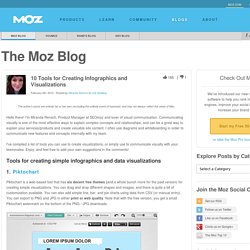
Teachers Can Use Social Media to Enhance Learning. Social media use has expanded to include even the world’s academic fraternity.

College professors are suddenly using social media, mainly to connect with colleagues, to access news and appear in the buzz around it. What many don’t appreciate about social media is the fact that it can be used within a classroom situation to create more value to learning. This article gives you tips on how professors and teachers can use social media to improve their work and students' academic performance and success. Help them create blogs. Blogs were weblogs in the past.
A Must Have Poster on Digital Literacy. Dalescone.gif 700×525 pixels. How To Be Influential In A Digital World: 10 Leaders Reveal Their Secrets. I don’t know if you can remember your days at school where how many friends you had was something to be valued in the school playground. If you only had one or two friends you were viewed as something of a loser. Being the leader of a group or “gang” you were seen as influential and could wield power and make your followers take action through coercion or through your influence.
20 Tips To Promote A Self-Directed Classroom Culture. 20 Tips To Promote A Self-Directed Classroom Culture. 9 Ways Neuroscience Has Changed The Classroom. There is often a big divide between what happens in the laboratory and the way laboratory findings are practically applied. The relationship between neuroscience research and education is no exception. While there are numerous educational products that claim to be based on neuroscience research (often quite dubiously so), the real impact of brain-based research on education has been much more subtle. While neuroscience hasn’t yet radically changed the way we think about teaching and learning, it is helping to shape educational policies and influencing new ways of implementing technology, improving special education, and streamlining day-to-day interactions between teachers and students.
7 Essential Principles of Innovative Learning. 30 Habits Of Highly Effective Teachers. Critical Thinking Model 1. Blooming Orange: Bloom's Taxonomy Helpful Verbs Poster. Jot 1×1 pixels. Study Shows How Classroom Design Affects Student Learning. Scott Steinberg: Teaching Technology: 10 Lessons Every School Should Share.
How A Good Teacher Becomes Great. Use the Socratic Method to Easily Win Arguments. What Does It Mean to Be a “Change Leader” in Education? The Best Resources For Helping Teachers Use Bloom’s Taxonomy In The Classroom. Bloom’s & SOLO ‘are not Just Colorful Posters we Hang on the Wall’ is my two-part series at Education Week Teacher.
Bloom’s Taxonomy is talked about a lot in educational circles. However, if you believe a recent survey of visits to 23,000 U.S. classrooms, the higher-order thinking skills it’s ideally designed to promote doesn’t get much use. Essay on how to end student complaints on grades. A Simple Guide To 4 Complex Learning Theories.
Top 10 Posts of 2012: Deep, Meaningful and Creative Learning. Igniting a learning revolution. Do You Perform Better in Situations With Competition or Collaboration? Studies Link Students' Boredom to Stress. Students as Teachers – Designers of Weekly Activities. Seeing Students As Co-Collaborators. Movement breaks help learning, well-being. Teaching Jobs Abroad Advice: Tips by Gregory Rogan of TeacherPort. How-to Remain Relevant in Higher Ed with ‘Active Learning’ The Four Pillars of Technology Use in the Classroom. 60 Sites for Digital Storytelling Tools and Information. Ten Secrets To Surviving As A Teacher. Good Storytelling Resources. Mind Mapping: Online Collaboration Tool « ROI HUNTERS Field Journal. The 60-Second Guide To Teaching With Tablets. TeacherCast.net: Educational Blogs, App Reviews, Podcasts, Screencasts, LiveBinders and Career Center.